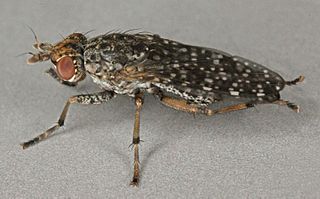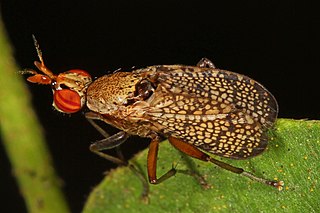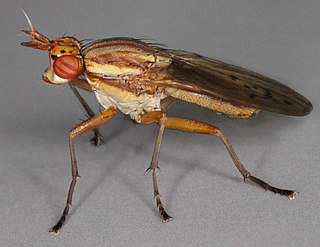
The family Sciomyzidae belongs to the typical flies (Brachycera) of the order Diptera. They are commonly called marsh flies, and in some cases snail-killing flies due to the food of their larvae.

The Ulidiidae or picture-winged flies are a large and diverse cosmopolitan family of flies (Diptera), and as in related families, most species are herbivorous or detritivorous. They are often known as picture-winged flies, along with members of other families in the superfamily Tephritoidea that have patterns of bands or spots on the wings. Some species share with the Tephritidae an unusual elongated posteroapical projection of the anal cell in the wing, but can be differentiated by the smoothly curving subcostal vein. Two species, Tetanops myopaeformis and Euxesta stigmatias, are agricultural pests.

The Pyrgotidae are an unusual family of flies (Diptera), one of only two families of Cyclorrhapha that lack ocelli. Most species are "picture-winged", as is typical among the Tephritoidea, but unlike other tephritoids, they are endoparasitoids; the females pursue scarab beetles in flight, laying an egg on the beetle's back under the elytra where the beetle cannot reach it. The egg hatches and the fly larva enters the body cavity of the beetle, feeding and eventually killing the host before pupating. In the United States, some species of Pyrgota and Sphecomyiella can be quite common in areas where their host beetles are abundant. Like their host beetles, these flies are primarily nocturnal, and are often attracted to artificial lights.

Suillia is a genus of flies in the family Heleomyzidae. There are at least 130 described species in Suillia.

Pherbellia is a genus of flies in the family Sciomyzidae, the marsh flies or snail-killing flies. They occur throughout the world, except for the Subantarctic region.

Anticheta is a genus of flies in the family Sciomyzidae, the marsh flies or snail-killing flies.
Atrichomelina is a genus of flies in the family Sciomyzidae, the marsh flies or snail-killing flies.

Colobaea is a genus of flies in the family Sciomyzidae, the marsh flies or snail-killing flies.

Limnia is a genus of flies in the family Sciomyzidae, the marsh flies or snail-killing flies.

Dictya is a genus of marsh flies in the family Sciomyzidae. There are at least 20 described species in Dictya.

Tetanocerini is a tribe of flies in the family Sciomyzidae. There are more than 400 described species in the tribe.

Elgiva is a genus of marsh flies in the family Sciomyzidae. There are about eight described species in Elgiva.

Tetanocera is a genus of marsh flies, insects in the family Sciomyzidae. There are at least 50 described species in Tetanocera.

Paralimna is a genus of shore flies.
Sepedon pacifica is a species of marsh fly.

Ilione is a genus of flies in the family Sciomyzidae, the marsh flies or snail-killing flies.
Sepedonea is a genus of flies in the family Sciomyzidae, the marsh flies or snail-killing flies.

Sciomyzinae is a subfamily of flies in the family Sciomyzidae.














